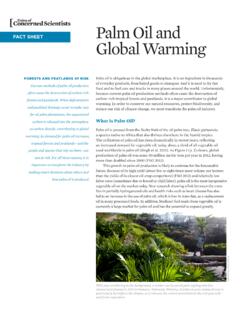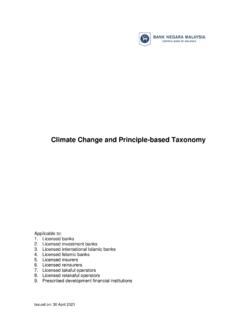Transcription of Peatlands factsheet - UK Centre for Ecology & Hydrology
1 Peatlands factsheet Q. What are Peatlands ? A. Peatlands are carbon-rich wetlands which occupy 3% of the global land surface and 12% of UK land area. The waterlogged conditions prevent plant material from fully decomposing and peat soil is formed by the partially decayed material, which builds up slowly. Natural vegetation in Northern Hemisphere Peatlands is mainly mosses, sedges and shrubs, while in the tropics they are naturally forested. In the UK, there are 3 types of peatland: o Blanket bog large areas of peat found largely in uplands fed primarily by rainfall o Raised bog localised domes of peat in lowland areas fed primarily by rainfall o Fens (pictured) fed by mineral-rich groundwater and river water, as well as rainfall Q: Why are Peatlands important?
2 A: Peatlands are among the most carbon-rich ecosystems on Earth. In a natural condition, Peatlands have a net cooling effect on climate , reduce flood risk, and support biodiversity . Healthy Peatlands can reduce flood risk by slowing the flow of water from the uplands, and by providing floodplain storage in the lowlands. They also provide important nesting and feeding grounds for many wading birds, as well as important habitats for rare insects and plants. Due to the unique flora and fauna they support, and their global rarity, blanket bogs have sometimes been referred to as the rainforests of the UK.
3 Q. How do healthy Peatlands mitigate climate change? A. Healthy Peatlands capture CO2 from the atmosphere through photosynthesis. Because the plants that grow on Peatlands do not fully decompose under wet conditions, they do not release carbon which would otherwise be returned to the atmosphere as CO2. Peatlands store vast quantities of carbon locking in an estimated billion tonnes in the UK alone, and where peat continues to form this helps to offset the effects of human activities (such as fossil fuel burning) that are raising CO2 levels in the atmosphere, leading to climate change.
4 However, overall, Peatlands in the UK and around the world are estimated to be a net source of greenhouse gas emissions to the atmosphere, as opposed to a net sink, due to the way they have been managed now and in the past. Q. Why is peatland exploited by humans? A. Although wetlands are naturally productive systems, most of the food and fibre crops that support human life require dry conditions. As a results, farmers and foresters have drained large areas of upland and lowland peat throughout the UK. Lowland fen peat has been particularly affected because it is very fertile when drained, supporting the production of valuable arable and horticultural crops.
5 For example, peat soils in the East Anglian fens are highly valuable for agriculture, producing a large proportion of the UK s salad crops and one-third of England s fresh vegetables, supporting a food chain worth more than 3 billion a year. Large areas of upland bog have also been drained for conifer forestry and livestock grazing, while other areas are rotationally burned as part of grouse shooting estates. Peat has also been extracted (mined) from many lowland raised bogs around the UK and Ireland for use as a growing medium by the horticulture industry and by gardeners.
6 Q. What is the impact of peatland degradation? A. Around 80% of UK peatland has been affected due to human activities which are: Draining the soil so it is not waterlogged, in order to make it suitable for crop and tree growth leads to the decomposition of plant material and soil shrinkage. This releases carbon into the air and is thereby a source of CO2 emissions into the atmosphere. While it takes 1,000 years for 1m of peat to build up, drainage means the land surface reduces an average of 1cm to 2 cm per year through subsidence due to peat oxidation. Drainage also means large areas of lowland peat, notably in the East Anglian Fens, are now below sea level and at risk from flooding The creation of ditches to enable drainage also provides channels for the rapid flow of water, which may increase flood risk downstream Drying out the peat soil allows shrubby vegetation to grow, and makes the land more vulnerable to severe wildfires.
7 Fire (caused by managed burning, accidental spread or arson) also produces CO2; for example a major wildfire on peat in the Scottish Flow Country is thought to have doubled Scotland s greenhouse gas emissions during the six days it was burning Q. How much peatland is there in the UK? A: Peatland covers around 3 million hectares in this country: 22% of the total peatland area remains in a near-natural condition, comprising undrained bogs and fens 41% of the UK peat area remains under semi-natural peatland vegetation, but has been affected by human activities including drainage, burn-management, livestock grazing and the cutting of peat for fuel 16% is covered by woodland, the majority of which is drained conifer plantation 15% is occupied by agricultural cropland and grassland, mainly in lowland regions of England such as the Fens, Norfolk Broads.
8 Manchester Mosses and Somerset Levels Industrial peat extraction for horticultural use occupies of UK peatland, mostly on lowland raised bogs Q: How many greenhouse gas emissions are UK Peatlands producing? A: The first comprehensive research into emissions from peatland areas in the UK was carried out in a study led by the UK Centre for Ecology & Hydrology and the James Hutton Institute. It estimated the overall, net, greenhouse gas (GHG) emissions from Peatlands could exceed the equivalent of around 20 million tonnes of CO2 each year. This revised calculation adds around 4% to the UK s previously estimated total annual GHG emissions.
9 Globally, scientists estimate Peatlands are emitting the equivalent of 1-2 billion tonnes of CO2, which is around 2-4% of all human greenhouse gas emissions. A large proportion of these emissions are being produced by the tropical Peatlands of Southeast Asia. Q. How will degrading Peatlands affect farming in the long term? A. The degradation of Peatlands has a negative impact on soil health over time, affecting the long-term viability of agriculture in those areas. Peat subsidence due to drainage also increases the need for expensive pumping to maintain conditions suitable for crop growth, and increases the risk of flooding.
10 Raising water levels could benefit farmers by extending the productive lifetime of the soil, as well as reducing both CO2 emissions and flood risk. Q. Is there a willingness among government agencies and NGOs to reduce emissions? A. Based on research and monitoring by UKCEH and other organisations, the UK Government, NGOs, scientists and the agricultural sector increasingly recognise the environmental impacts and costs of degrading Peatlands . Reducing GHGs from Peatlands is key to the UK s ambition of reaching net zero emissions by 2050. Peat restoration is national government policy in England, Scotland, Wales and Northern Ireland.







